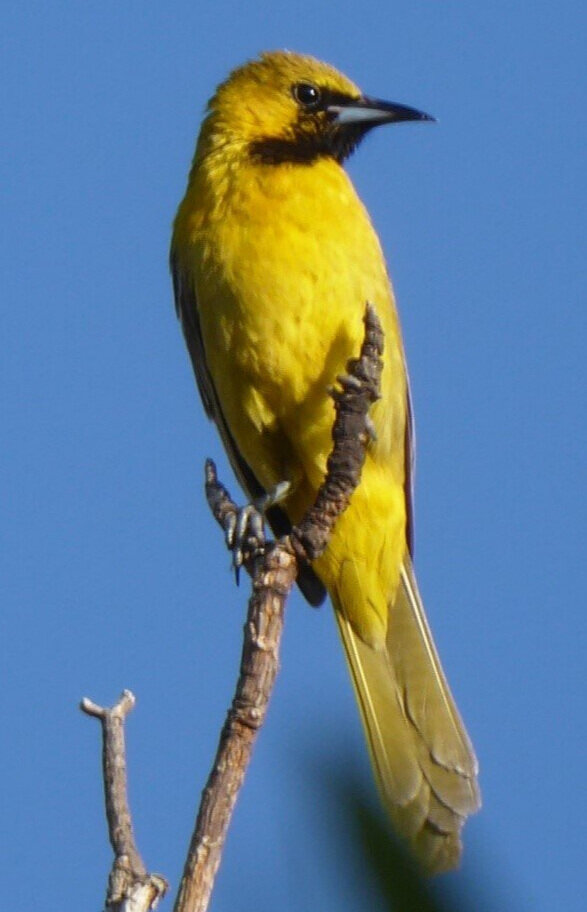The Birds of Summer
Jeanie Anderson
Greetings everyone! Jeanie here. I lead some of our bird hikes in the Preserve and want to introduce you to several of our summer visiting avian favorites, all in the passerine or perching bird family. These birds visit to breed and enjoy the fine dining during summertime in San Diego.
First, let’s discuss the brightly-colored Hooded Oriole. This species is a member of the Icterids or blackbird family. As an orchard bird, it loves fruit, nectar and insects, think juicy worms. Backyard birders have success putting out oranges, grape jelly and special orange juice feeders. In the canyon, you might see a flash of bright yellow and black from the mature males or a more muted green from females and first year males.
Sometimes we hear the orioles and don’t see them… so listening for their distinctive call is one way to recognize them. It’s a loud “VEEK”! You can actually “VEEK“ call back to them and have an avian conversation for a few minutes. They often nest in palm trees.
Hooded Orioles visit us from Mexico’s southwestern coast, arriving in early April and departing at the end of summer. Males leave first, while females and young leave a bit later to allow the young to get strong and conditioned for the journey. I’m sad to see them leave.
Two hooded orioles are pictured below. Note the black face, throat-battling bees and white wing bars on the male (left). Not to be left out, a female Hooded Oriole on an orange juice feeder (right).
Next in the brightly colored category is our spring and summer visiting Black-headed Grosbeak. This bird is a seedeater and you may have them visit your feeders, but they also enjoy fruit as I can attest in my orchard! The male has very bright orange and black markings (do we see a pattern here?) while the female is a somewhat more muted peach. They both sing and the female sings on nest – highly unusual in the bird world!
Looking at their thick bill, you can see how they are designed to crack seeds… think sunflowers.
They have a lovely lilting song, which the books describe as a whistled warble. Their call is a distinctive high, sharp “PIK”! We heard them on our hike in the canyon last week but did not see them. They are quite shy.
Next on the roundup of visitors are the flycatchers, birds we owe a debt of gratitude for their insect foraging appetites. My favorite little ball of fluff is the Pacific-slope Flycatcher. More often heard than seen, this summer visitor to our canyon has a notable high, thin whistle. The books call it “a slurred tseeweep “. It reminds me of the whistle one makes to call their dog. I have been quite successful duetting this whistle with the Pacific Slope, sometimes never seeing the actual bird.
Here is my image from a few years ago, highlighting the notable oval eye ring behind his eye, yellow-olive in color. A little bird, only 5.5 inches in length, this small flycatcher winters in western Mexico.
Try whistling “tweesweep” to them!
Rounding out our flycatcher visitors, we are graced by the handsome Ash-throated Flycatcher. They are about 8.5 inches in length, with a very pale yellow breast, whitish throat, dark tail feathers and a slight crest at times. You may hear their call, a sharp “bik“.
Here is a nice image of the Ash-throated flycatcher from All About Birds
And last, but not least, we have an amazing flyer, the Northern Rough-Winged Swallow! Say that 5 times! Look for their plain brown backs, dusky throats, and buff breast.
These birds are aerial acrobats, dipping and soaring on pointed wings, with notched tails to capture insects on the wing, singing the whole time. We especially enjoy them in the evenings over the Preserve, dancing in the skies as they find dinner delicacies. This swallow summers all over the US and winters in Mexico and Central America. Watch and you will see their joie de vivre on wing!
Northern Rough-Winged Swallow. Image from Flicker






